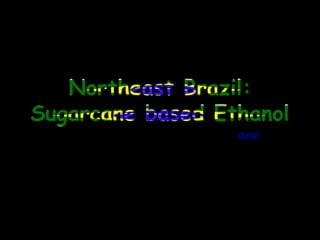
Northeast Brazil
- 1. Northeast Brazil: Sugarcane based Ethanol etanol
- 2. History Sugarcane: 16th century: Portuguese introduce plantations and sugarcane to NE Brazilian coast By the end of the 16th century, Brazil is one the world’s richest colonies due to high European demand for sugar Indigenous slave labor not valued; sugar demand and african slave import “Ideal’ model of success assumed and sugar plantations w/ African labor grows into Amazon region. Not successful due to unsuitable land. Bahia Amazon
- 3. Ethanol Properties Fermentation: Prime process; microbial conversion of sugar in plant material. It leads directly to ethanol, CO2 and other by-products. Recovery of ethanol from fermentation broth: 1. Distillation of the dilute alcohol to its azeotrope (95-57% ethanol by weight); 2. Distillation utilizing a 3rd component (organic solvent or strong dehydrating agent) to break up the azeotrope and remove the remaining H20; 3. Distillation to separate H20 from the 3rd component to give absolute alcohol and allow the 3rd component to be recycled.
- 4. Sugarcane Ethanol Yields Source: Humphreys and Glasgow Ltd., 1980
- 7. History Ministry of Agriculture authorized to assign contracts to support sugar mills for pure alcohol production 1932 Avg. annual ethanol content in ethanol/gasoline blends reaches 40% in NE Brazil 1942-1956 European consumption of alcohol based fuel tops ½ mill. tons /yr 1939 1933 Institute of Sugar and Alcohol (IAA) established 1942 Minimum price (P) for alcohol is established for a 4 yr min. 1960-1965 sugar P in intl. market and low petroleum P reduces role of ethanol in Brazil. Law No. 4.452 modifies tax legislation on fuels and introduces an additional one alcohol
- 8. History Beginning of manufacture of neat-ethanol cars by auto industry and selling of neat alcohol fuel at service stations. 14% of Brazil’s gasoline D is displaced 1979 Fleet tests begin for neat-ethanol (Otto) car engines. Blend reaches 45% ethanol and deploys 5% of Brazil’s gasoline D 1977 sugar P in intl. market. Upper limit of alcohol/gasoline blends from 5%-10% 1966-1967 1982 10% of total passenger cars or 1.2 million Otto engines projected 1978 50 blending centers supply ethanol/gasoline blends of up to 60% ethanol. 11% Brazilian D for gasoline displaced 1973 Oil Crisis begins PNA (Natl. Alcohol Program) created to promote ethanol production. Plan was to alcohol use and displace Brazil’s gasoline demand (D)
- 10. Expansion Period
- 11. History Ethanol market is deregulated and subsidies are removed 2000 90% of Brazil’s automotive industry were E100 Late 1980’s Mandate of atleast E25 in all vehicles established. June 2007 2003 Flex Fuels introduced. cars may run on E100, on E25, or any combination if the 2 October 2008 Brazil has 33,000 gas stations offering ethanol next to gasoline 1990 Brazil automotive industry reduces to only 10% due to ethanol shortage
- 16. Food vs. Fuel and Environment Anti-energy crops Compete w/ food crops for land Compete for rural investment which might be used to raise food crops Use food as a feedstock for industry rather than food for people and their animals Compete for water supplies-fermentation requires large quantities of water (16 litres/litre of alcohol) Energy crop enthusiasts Energy crops are in addition to food crops Energy crop programmes will reduce oil import bills and save foreign exchange- which might be used to buy necessary food on the world grain market 1980 arguments
- 17. Food vs. Fuel and Environment Current Arguments Anti-energy crop Energy crop enthusiasts Cattle and food crops being displaced Deforestation Soil Degradation October 2008: speculation that 400,000 jobs will be lost due to growing mechanization Increased mechanization will decrease GHG emission reduction Food + Fuel Sugarcane mills are self-sufficient. 1975-2000: Deployment of gasoline w ethanol reduced carbon emissions by 100 million tons. Brazil is energy independent Government promises that not a single stalk of sugar cane will be found in the rainforest
- 18. Source: Unicamp 2007
- 20. Multigrain Owned by Japan’s Mitsui & Co Ltd; U.S. CHS Inc.; and Brazil’s PMG Trading SA Pres. Paulo Garcez: “We plan to sell the ethanol on the local market initially and, in a 2nd phase, export it” 2003: bought 1st farm in Bahia for cotton and soy Owns Xingu, large farm (50mi width) Invested over $400mil just in land
- 21. Xingu Owned by Multigrain, large farm (50mi width) Invested over $400mil just in land Includes: Grain crushing plant 200 houses for workers School Hospital Church
- 22. Xingu Self sufficient in water Plans for self sufficiency in electricity: Construct $350mil ethanol mill cogeneration thermal energy plant
- 24. Sustainability Criteria Certification process: could impose new barriers for Intl trade Zoning: Adequate areas determined by: a) soil and weather adequacy b) topography c) water availability and requirements d)sugarcane can’t be planted in sensible ecosystems e) areas where other crops have been produced
- 27. Majority of growth to take place in Centre-South
- 28. An additional 7 mill hectares will be cultivated this year
- 29. Satellite monitoring system and supervision of the rainforest will be strengthened
- 30. Domestic consumption: Export:35 billitres by 2015 15 billitres by 2020 50 billitres by 2020
- 31. Future From 2008-2012 US $33 billion should be invested. US $23 billion in new mills. Industrial units controlled by foreign capital should rise from about 7%-12% by 2012.
Hinweis der Redaktion
- Azeotrope: Greek word meaning “no change on boiling”. mixture of two or more liquids (chemicals) in such a ratio that its composition cannot be changed by simple distillation.
- Bagasse (residue not used for ethanol) provides enough heat energy to power the mill and electricity to be sold on the consumer electricity grid. Bagasse may be used to produce paper and reduce deforestation